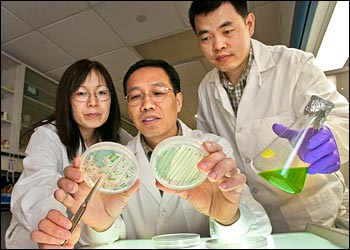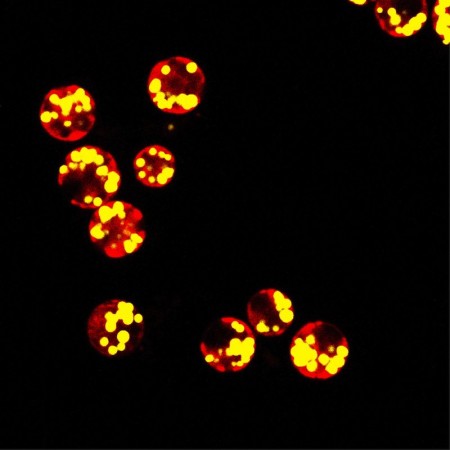Jun
20
Algae Get a Better Diet
June 20, 2012 | 1 Comment
Till now the understanding of the regulatory mechanisms controlling oil biosynthesis and storage in micro algae and details of the oil biochemistry was rather limited. Brookhaven National Laboratory scientists are now showing corrections for two long-held misconceptions about oil production in algae by proving that ramping up the microbes’ overall metabolism by feeding them more carbon increases oil production as the organisms continue to grow.
Before the Brookhaven research work published, a main approach to optimizing oil production in algae was to starve the algae of certain key nutrients, such as nitrogen. That way oil output would increase, but the algae would stop growing, which isn’t an ideal outcome for continuous production.
Brookhaven biologist Changcheng Xu, the paper’s lead author, explains the position the efforts tries to solve, “We are interested in algae because they grow very quickly and can efficiently convert carbon dioxide into carbon-chain molecules like starch and oils.”
The motive in simple terms is algae has eight times the energy density of starch, meaning algal oil in particular could be an ideal raw material for making biodiesel and other renewable fuels. Algae’s other characteristics drive intense interest.
Algae for fuel has been beset with problems that keep the price too high for a competitive product.
At the very start, when the tiny microbes take in carbon dioxide for photosynthesis, they preferentially convert the carbon into starch rather than oils. “Normally, algae produce very little oil,” Xu said.
“Much of what we thought we knew was inferred from studies performed on higher plants,” said Brookhaven biochemist John Shanklin, a co-author who’s conducted extensive research on plant oil production. Recent studies have hinted at big differences between the microbial algae and their more complex photosynthetic relatives.
Xu continues, “Our goal was to learn all we could about the factors that contribute to oil production in algae, including those that control metabolic switching between starch and oil, to see if we could shift the balance to oil production without stopping algae growth.”
The scientists grew cultures of Chlamydomonas reinhardtii, considered the “fruit fly”, if you will allow, of algae, under a variety of nutrient conditions, with and without inhibitors that would limit specific biochemical pathways. They also studied a mutant Chlamydomonas that lacks the capacity to make starch. By comparing how much oil accumulated over time in the two strains across the various conditions, they were able to learn why carbon preferentially partitions into starch rather than oil, and how to affect the process.
The principle discovery was that feeding the algae more carbon (in the form of acetate) quickly maxed out the production of starch to the point that any additional carbon was channeled into high-gear oil production. And, most significantly, under the excess carbon condition and without nutrient deprivation, the microbes kept growing while producing oil.

Brookhaven researchers Jilian Fan, Changcheng Xu, and Chengshi Yan. Click image for the largest view.
In the detailed studies, conducted mainly by Brookhaven research associates Jilian Fan and Chengshi Yan, the results show that the amount of carbon was the key factor determining how much oil was produced: more carbon resulted in more oil; less carbon limited production. This was another surprise because a lot of approaches for increasing oil production have focused on the role of enzymes involved in producing fatty acids and oils. In this study, inhibiting enzyme production had little effect on oil output.
Here is an instructive note from the research: “This is an example of a substantial difference between algae and higher plants,” points out Shanklin. In plants, the enzymes directly involved in the oil biosynthetic pathway are the limiting factors in oil production. In algae, the limiting step is not in the oil biosynthesis itself, but further back in central metabolism.
Hu takes the new knowledge a bit further. It’s not all that different from what we see in human metabolism, Xu points out: Eating more carbon-rich carbohydrates pushes our metabolism to increase oil (fat) production and storage.
Who would have thought that algae in this sense would be more animal like than plant like?
“It’s kind of surprising that, in some ways, we’re more like algae than higher plants are,” Xu said, noting that scientists in other fields may be interested in the details of metabolic switching uncovered by this research.
The next step for the Brookhaven team will be to look more closely at the differences in carbon partitioning between algae and plants. This part of the work will be led by co-author Jorg Schwender, an expert in metabolic flux studies. The team will also work to translate what they’ve learned in a model algal species into information that can help increase the yield of commercial algal strains for the production of raw materials for biofuels.
It might seem odd that algae respond more like an animal than a plant to nutrient intake, but now the proof is at hand. Another scientific assumption bites the dust. The algae can be fat and happy and we’re a good step closer to current CO2 cycling back to fuel.
It’s a good thing when scientific assumptions are challenged.
Comments
1 Comment so far



Thankfulness to my father who informed me concerning this webpage, this weblog
is really amazing.